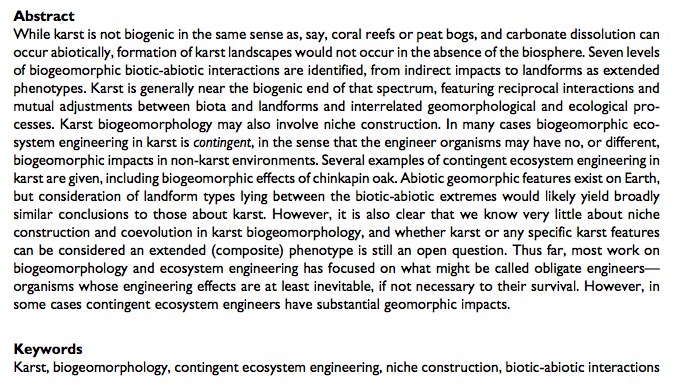Many biogeomorphic ecosystem engineer organisms exert their biogeomorphic effects through intrinsic activities and behaviors that occur wherever the organism occurs. Ants, earthworms, sphagnum mosses, and marsh grasses, for example are going to have the same qualitative ecosystem engineering impacts wherever they occur. In other cases, however, biogeomorphic impacts may differ (or even occur) in different geomorphic settings or habitats. This can be called contingent ecosystem engineering, because the effects are contingent on the environmental setting. For example, beavers build dams to create suitable pond habitats, with attendant geomorphic effects on streams. However, where water is deep enough (that is, there is suitable habitat without damming a stream), they don’t bother building dams or lodges (though they do have different biogeomorphic impacts, via burrowing into banks for their lodges). Thus the ecosystem engineering impacts are contingent on the hydrophysical properties of the stream. An example of an organism where the existence (not just the nature or degree) of biogeomorphic effects is contingent is the sulfate reducing bacterium Desulfovibrio desulfuricans. This microbe is found in soil, water, and living organisms in a wide variety of settings. However, in water with high partial pressures of carbon dioxide (such as occur in karst environments), Desulfovibrio desulfuricans stimulates carbonate precipitation, which is an important geomorphic process in caves and karst settings.

Pathways for ecosystem engineering & nich construction. Where phenomenona in the shaded boxes depend on the environmental setting, contingent ecosystem engineering is possible.
This is the theme of the just-published Biogeomorphology and Contingent Ecosystem Engineering in Karst Landscapes (Progress in Physical Geography, vol. 40, p. 503-526). The paper highlights the phenomenon of contingent ecosystem engineering (CEE) in general, with a focus on karst. While CEE may be somewhat more common in karst than other geomorphic systems (we still don’t know enough yet to be sure), it is certainly not limited to karst. The paper also includes a consideration of a range of biotic-abiotic interactions in geomorphology (from a few completely abiotic landforms to some cases where landforms can be considered extended composite phenotypes, though whether any karst features fall into the latter category is still an open question.

Abstract of the article is below:

